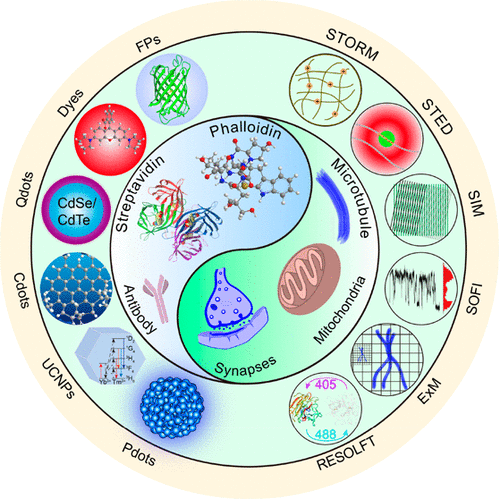当前位置:
X-MOL 学术
›
Bioconjugate Chem.
›
论文详情
Our official English website, www.x-mol.net, welcomes your
feedback! (Note: you will need to create a separate account there.)
Fluorescent Bioconjugates for Super-Resolution Optical Nanoscopy.
Bioconjugate Chemistry ( IF 4.0 ) Pub Date : 2020-07-10 , DOI: 10.1021/acs.bioconjchem.0c00320 Zhihe Liu 1 , Jie Liu 1, 2 , Xiaodong Wang 1 , Feixue Mi 1 , Dan Wang 3 , Changfeng Wu 1
Bioconjugate Chemistry ( IF 4.0 ) Pub Date : 2020-07-10 , DOI: 10.1021/acs.bioconjchem.0c00320 Zhihe Liu 1 , Jie Liu 1, 2 , Xiaodong Wang 1 , Feixue Mi 1 , Dan Wang 3 , Changfeng Wu 1
Affiliation

|
Fluorescent microscopy techniques are widely used in biological studies. However, the spatial resolution of fluorescent microscopy is restricted by the optical diffraction limit. In the past two decades, super-resolution imaging techniques with different principles have been invented to visualize biomolecules at nanometer scales. The development of nearly all these techniques is closely related to the advances in fluorescent probes. In particular, the intrinsic properties of fluorescent probes constrain the optimal imaging performance of super-resolution nanoscopy techniques. In this review, we summarized the recent progress in fluorescent probe bioconjugates for super-resolution imaging techniques. Examples of these bioconjugates include the widely used fluorescent proteins (FPs), organic dyes, quantum dots (Qdots), carbon dots (Cdots), upconversion nanoparticles (UCNPs), aggregation induced emission (AIE) nanoparticles, and polymer dots (Pdots). Based on the characteristics of the existing probes and their adaptability in current imaging methods, we provide a perspective for further development of fluorescent probes for super-resolution imaging.
中文翻译:

用于超高分辨率光学纳米显微镜的荧光生物共轭物。
荧光显微镜技术已广泛用于生物学研究。但是,荧光显微镜的空间分辨率受到光学衍射极限的限制。在过去的二十年中,发明了具有不同原理的超分辨率成像技术,以可视化纳米尺度的生物分子。几乎所有这些技术的发展都与荧光探针的发展密切相关。特别是,荧光探针的内在特性限制了超分辨率纳米技术的最佳成像性能。在这篇综述中,我们总结了用于超分辨率成像技术的荧光探针生物缀合物的最新进展。这些生物结合物的例子包括广泛使用的荧光蛋白(FPs),有机染料,量子点(Qdots),碳点(Cdots),上转换纳米粒子(UCNP),聚集诱导发射(AIE)纳米粒子和聚合物点(Pdot)。基于现有探针的特性及其在当前成像方法中的适应性,我们为进一步开发用于超分辨率成像的荧光探针提供了前景。
更新日期:2020-08-19
中文翻译:

用于超高分辨率光学纳米显微镜的荧光生物共轭物。
荧光显微镜技术已广泛用于生物学研究。但是,荧光显微镜的空间分辨率受到光学衍射极限的限制。在过去的二十年中,发明了具有不同原理的超分辨率成像技术,以可视化纳米尺度的生物分子。几乎所有这些技术的发展都与荧光探针的发展密切相关。特别是,荧光探针的内在特性限制了超分辨率纳米技术的最佳成像性能。在这篇综述中,我们总结了用于超分辨率成像技术的荧光探针生物缀合物的最新进展。这些生物结合物的例子包括广泛使用的荧光蛋白(FPs),有机染料,量子点(Qdots),碳点(Cdots),上转换纳米粒子(UCNP),聚集诱导发射(AIE)纳米粒子和聚合物点(Pdot)。基于现有探针的特性及其在当前成像方法中的适应性,我们为进一步开发用于超分辨率成像的荧光探针提供了前景。











































 京公网安备 11010802027423号
京公网安备 11010802027423号